Yellow Camellia Species
Anthony S. Curry
When the terms yellow Camellia, yellow-flowered Camellia or golden Camellia are mentioned we generally think of one species, Camellia nitidissima (syn. C. chrysantha) from Guangxi Zhuang Autonomous Region (Guangxi) in southern China and North Vietnam. It is this species that has been available to western gardeners and horticulturists since the 1960’s. However there is a galaxy of yellow camellias that remains largely unknown to most Camellia collectors and western gardeners and horticulturists.
Depending on which taxonomic treatment you use there are between 82 and 300 species of Camellia. Of the total number of Camellia species, between ten to fifty (10-50) yellow- flowered Camellia species are mentioned in the literature. The three main taxonomies referred to are: Joseph Robert Sealy’s – “A Revision of the Genus Camellia” (1958), Professor Chang Hung Ta and Bruce Bartholomew’s – “Camellias” (1981) and Ming Tien Lu’s – “A Systematic Synopsis of the Genus Camellia” (1999). The variation in species numbers for each of the taxonomic systems are set out in Table 1.
|
Taxonomic Treatment |
Sealy (1958) |
Chang (1984) |
Ming (1999) |
|
Number of Camellia species |
82 |
200 |
119 |
|
Number of Yellow Camellia Species |
10 |
20 |
19 |
Table 1. A comparison of the three taxonomic treatments of the genus Camellia: total species numbers and number of yellow flowered Camellia species.
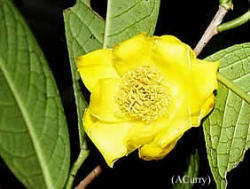 |
| Camellia crassiphylla |
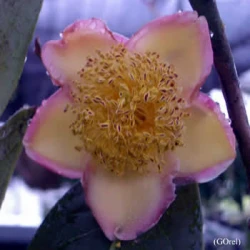 |
| Camellia dongnaiensis |
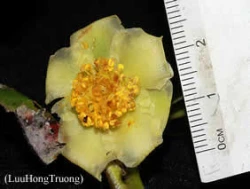 |
| Camellia inusitata |
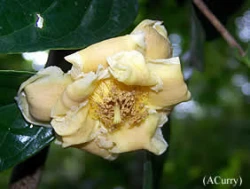 |
| Camellia luteocerata |
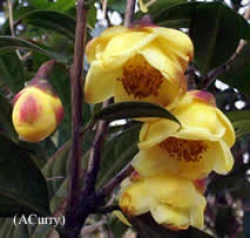 |
| Camellia nitidissima |
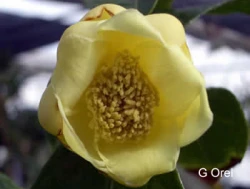 |
| camellia vidalii |
The yellow or golden Camellia species have for some time been considered as members of Chang Hung Ta’s Section: Chrysantha, but other ‘sections’ of Camellia also contain yellow- flowered species depending upon which author you refer to, e.g. Sealy’s treatment has yellow camellias in sections: Archecamellia, Stereocarpus, Corallina, Heterogenea and Dubiae; Chang’s system has yellow camellias in sections: Stereocarpus, Luteoflora, Corallina, Brachyandra, Longipedicellata and Chrysantha while Ming’s treatment has yellow camellias in sections: Archecamellia, Corallinae, Stereocarpus and Heterogenea.
Thomas James Savige in his article ‘Golden Camellias' (International Camellia Society Journal No.25, p.59 (1993)) states that Joseph Robert Sealy included four (4) species of yellow flowered camellias in his ‘Revision of the Genus Camellia’ published in 1958, namely Camellia flava from Mt Chua Hac, C. euphlebia from Tien Yen, C. fleuryi from the Hon-Ba Massif and unknowingly C. nitidissima from Kwangtung. However after closer scrutiny of Sealy’s revision there appears to be another six (6) species of golden camellias enumerated, i.e. Camellia tonkinensis (unknowingly) from Ba Vi Mountain, C. petelotii (unknowingly) from Tam Dao, C. dormoyana from Bien Hoa and Dounai Provinces, C. amplexifolia from Hainan, C. gilbertii from Phu-ho Province and C. paucipunctata from Hainan. As at 1958 ten (10) species of yellow flowered camellias had been described or at least partially published. However at this time the Camellia world had neither gained a full appreciation of, nor fully accepted, yellow camellias as genuine entities or plants of merit and worthy of cultivation.
Chin Wen Chi, a Chinese botanist, in 1948 was the first author to assign the specific epithet ‘nitidissima’ (from L. nitid: lustrous, shining and issima: the superlative degree) to a Camellia species. This species originated from Kwangtung, (Guangxi Zhuang Autonomous Region), and he named it, Camellia nitidissima (Sunyatsenia 7: 19. 1948), in reference to the appearance of the leaves of this species.
In 1960 the discovery of a population of yellow-flowered camellias on the Sino-Vietnamese border led to Professor Hu’s work and the description of Theopsis chrysantha (Acta Phytotaxonomica Sinica. 10: 2. 139) in 1965. Savige expounds in ‘Golden Camellias’ (International Camellia Society Journal No.25, p.59 (1993)), that it was Professor Hu’s description of the taxon, Theopsis chrysantha, and its publication in English in the Royal Horticultural Society’s ‘Rhododendron and Camellia Yearbook, No. 21 in 1967, that opened the eyes of the Western Camellia world to the realm of the Golden Camellia. In 1975 the Japanese botanist Takasi Tuyama reclassified Hu’s, Theopsis chrysantha, as Camellia chrysantha and with this reclassification the yellow Camellia emerged from obscurity and was firmly placed on the must have list for Camellia lovers worldwide. At the International Symposium on Camellia chrysantha in 1994 in Nanning Chang Hung Ta advised the symposium that C. chrysantha and C. nitidissima are synonymous (ICS Journal No. 26, p.70).
Sealy’s inclusion of Camellia nitidissima in Chapter 17 of his revision of the known Camellia species in 1958 was the second time this epithet appeared in the botanical literature and so it remained until the publication of Chang Hung Ta’s papers in 1991/2 and his passionate pleas for the recognition of the synonymy of C. chrysantha and C. nitidissima at the first International Symposium on Camellia chrysantha in Nanning, 8-11 January 1994. From this time on C. chrysantha has been officially recognized as a synonym of C. nitidissima. However the disputation over synonymy, precedence and validity of each of the species epithets still rages today.
Since the early 1980’s there has been great interest in the collection, documentation, culture, research and protection of the yellow-flowered Camellia species, especially Camellia nitidissima (syn. C. chrysantha). There seems to be even more interest in hybridization and breeding of a range of warm growing camellias with large, yellow-orange-apricot coloured blooms. However, of the thirty to sixty (30-60) species of yellow Camellias currently known, only C. nitidissima (syn. C. chrysantha) is commercially available.
To foster interest and a better understanding of the yellow flowered Camellia species a number of collections of yellow flowered Camellias have been established to research their ecology, culture, taxonomy and breeding including:
The ‘Camellia Gene Bank Garden:
is located in the Nanning Botanical Garden this garden houses the largest collection of Camellia nitidissima (syn. C. chrysantha) in the world. Founded in 1981, and officially opened in 1995, the ‘Gene Bank Garden’ holds collections of more than twenty (20) species, and over fifteen (15) varieties of C. nitidissima for conservation, research, plant breeding and general horticultural purposes. There are in excess of 3000 plants in the collection and more than seven thousand crosses have been performed using C. nitidissima and other Camellia species as parents. Some of the other species in the collection include C. achrysantha, C. ptilosperma, C. tunghinensis, C. murauchii, C. impressinervis and C. amplexicaulis – pink flowered species from Vietnam.
Liang Feng Jiang Natural Forest Park Nanning:
is administered by the Forestry Bureau of Guangxi Autonomous Region the park is situated in the Liang Feng Jiang Natural Forest Park on the outskirts of Nanning. This facility is much more than a park as it holds and preserves an impressive collection of Golden Camellias. Although it is on a smaller scale than the ‘Camellia Gene Bank Garden’ anyone interested in golden Camellia species should visit this forest park.
Guilin Botanic Garden Yanshan:
is located about 13km from Guilin at Yanshan and includes the Guangxi Botanical Institute and Herbarium. The sixty seven (67) hectare garden focuses on limestone karst plants as well as plants from low and high altitudes. The collection features many rare genera and species and the garden has the largest collection of limestone karst plants in China. At least seven species of yellow camellias are native to karst areas of Guangxi Province. The collection over 1700 plant species and includes about twenty (20) Camellia species including, C. nitidissima (syn. C. chrysantha), C. tunghinensis, C. euphlebia, C. terminalis, C. parvipetala, C. longistyla, C. longgangensis, C. ptilosperma, C. pubipetala, C. flavida, C. impressinervis, C. limonia forma obovata and C. pingguoensis.
The Jinhua International Camellia Species Garden:
is located in Jinhua City, Zhejiang Province Peoples Republic of China and was formally opened 2002. The garden comprises ten (10) hectares of garden and features over 200 Camellia species, about 80% of the known Camellia species. It is systematically laid out following Chang Hung Ta’s Camellia taxonomic system (1984).
The aims of the Jinhua International Camellia Species Garden are the conservation, cultivation, hybridization and utilisation of Camellia species. Its Camellia collection program is ongoing and the garden currently holds about twenty-five species, varieties and forms of yellow flowered Camellias including C. luteoflora, C. flava, C. euphlebia, C. achrysantha, C. impressinervis, Camellia nitidissima (syn. C. chrysantha), C. longgangensis, C. tunghinensis, C. parvipetala, C. limonia, C. pingguoensis, C. longzhouensis, C. liberofilamenta, C. flavida, C. ptilosperma and C. multipetala.
MORE INFORMATION
The Fangcheng Golden Camellia Nature Reserve and Gene Bank:
is situated in the Fencheng District of Fangchenggang City in southern Guangxi the reserve covers an area of 9915hectares and houses about twenty eight (28) species and varieties of Yellow flowered Camellias. The Nature Reserve is home to three (3) species of golden Camellia species, namely C. nitidissima (syn. C. chrysantha), C. euphlebia and C. tunghinensis. Gene Bank has been set up to conserve yellow flowered Camellia species including C. euphlebia, C. chrysantha, C. pubipetala, C. impressinervis, C. tunghinensis and C. ptilosperma as well as research and study their horticulture and use in the manufacture of herbal teas.
Kunming Institute of Botany:
was established in 1951 on thirty three (33) hectares in Kunming, Yunnan Province P.R. China. The institute has an extensive herbarium collection and systematic collections of monocotyledons, gymnosperms, Rhododendron and Camellia species. One of the main functions of the institute is the research into ornamental and commercial plants from sub tropical and alpine regions of China as well as scientific and taxonomic research relating to horticultural, medicinal and rare and endangered plants.
Over the years especial attention has been given to the research of the yellow flowered Camellia regions of Guangxi Province. Since 1965 the researchers from the Kunming Institute of Botany have investigated Longlin, Fangcheng, Longzhou and Long’an districts. This stimulated further interest in yellow camellias and more than twenty five (25) species and varieties have been cultivated. In 1973 an extensive breeding program was commenced using Camellia reticulata, C. pitardii and C. japonica as the seed (female) parents and three species of yellow flowered Camellias as the pollen (male) parents, including C. nitidissima (syn. C. chrysantha) and C. impressinervis.
MORE INFORMATION
Since the late1980's many species of yellow camellias have been discovered and described from Southern China as well as North and South Viet Nam for example:
Southern China:
- C. achrysantha by Chang Hung Ta
- C. fascicularis by Chang
- C. grandis by Chou Fen Liang & Sin Li Mo
- C. chuongtsoensis by Huang Liandong
North Viet Nam:
- C. crassiphylla by Tran Ninh & Naotoshi Hakoda
- C. cucphuongensis by Tran Ninh & Jean-Claude Rosmann
- C. hakodae by Tran Ninh
- C. rosmannii by Tran Ninh
South Viet Nam:
- C. vidalii by J-C Rosmann
- C. dongnaiensis by George Orel
- C. luteocerata by G. Orel
- C. inusitata by G. Orel, A. Curry & Luu Hong Truong
The story of the golden camellias is ongoing and convoluted. There are still new species being described and discovered, e.g.
Camellia chuongtsoensis from southern China (ICS Journal, 42, p. 84, Proceedings of the 3rd International Academic Forum on Yellow Camellias, Nanning Guangxi China, 21-23 February 2013, p.79), in 2010;
C. dalatensis (Tran, Hakoda & Luong) from Central Highlands of Viet Nam (ICS Journal, 44, pp.161-162) in 2012 and
C. dilinhensis (Tran & Luong) from Lamdong Province in South Viet Nam (Proceedings of the 3rd International Academic Forum on Yellow Camellias, Nanning Guangxi China, 21-23 February, p.79), pp.20-22) in 2013.
I am sure that there are still many more yellow flowered Camellia species to be found in the jungles of Southern China and Viet Nam!
Web design by Tribal Systems
